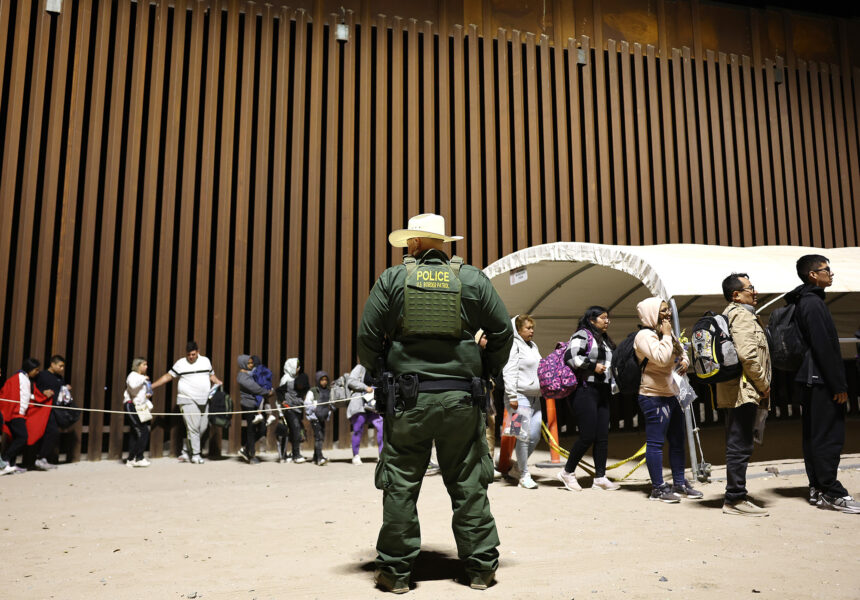- The right to apply for asylum is enshrined in U.S. and international law. The qualifications resemble those for refugee status, but asylum seekers follow a different process.
- Asylum claims have reached record levels in recent years, though they dropped early in the COVID-19 pandemic. In fiscal year 2022, the U.S. government granted asylum to more than thirty-six thousand migrants.
- President Joe Biden pledged to restore asylum access that had been curtailed under President Donald Trump, but a historic surge in migration at the U.S.-Mexico border is challenging his plans.
Introduction
The right to apply for asylum, a type of protection granted to migrants fleeing persecution or other harm in their home countries, has been a central component of U.S. immigration law for decades. But rising numbers of asylum seekers and a growing backlog in the system have increasingly challenged policymakers. President Donald Trump responded with a slew of policies to deter would-be migrants from making the often arduous journey to the southern U.S. border. President Joe Biden has reversed many Trump-era decisions, but a record number of illegal border crossings in fiscal year 2023 (FY 2023) have sparked political tensions between federal authorities and border state governors and reignited a fiery debate in Congress over immigration reform.
What is asylum?
Asylum is a form of legal protection that host countries grant to migrants who have been forcibly displaced and are fleeing harm or persecution, or the fear of persecution, in their place of origin. According to U.S. and international law, a claim of persecution must be made based on one of five “protected grounds”: race, religion, nationality, political opinion, or membership in a particular social group. (The breadth of this last category has stoked many legal debates.) The right to asylum is laid out in U.S. immigration law and Article 14 of the Universal Declaration of Human Rights; it is also outlined in the 1951 Refugee Convention and its 1967 Protocol. While asylum offers the same protection as refugee status, migrants seeking asylum in the United States must apply for it from within the country or at one of its 328 official ports of entry rather than from abroad.
According to the UN refugee agency, a record-breaking 2.6 million new individual asylum applications were registered worldwide in 2022, of which the leading source country was Venezuela, followed by Afghanistan and Cuba. At the close of the year, some 5.4 million global asylum seekers still had pending asylum claims, more than a third of which were in the United States. By mid-2023, that number had grown to 6.1 million [PDF].
How has the level of U.S. asylum claims changed over time?
Prior to the passage of the Refugee Act of 1980, the U.S. government granted asylum on an ad hoc basis, including in the aftermath of World War II and during the Cold War, though at times it refused asylum to certain immigrant groups. The 1980 law created the current statutory basis for asylum, guaranteeing family reunification rights and providing asylees, or migrants who receive asylum, with a path to permanent residency after one year.
Unlike with refugees, there is no numerical limit on the number of asylum requests that the government can grant each year. Additionally, officials can reject asylum applicants even if they qualify for refugee status under international law. Over the past few decades, the number of asylum grants has fluctuated significantly [PDF], from a little over one thousand in FY 1980 to record levels of more than forty-six thousand in FY 2019.
In the first few years of the COVID-19 pandemic, border closures, partial government shutdowns, and slow processing times led to a sharp drop in asylum approvals [PDF]. Meanwhile, the backlog of asylum cases pending in U.S. immigration courts kept growing; it currently sits at more than 1.1 million, the most on record.
Where do most asylum seekers in the United States come from?
The total number of asylum seekers almost quadrupled between fiscal years 2021 and 2022, with nearly five hundred thousand applications in FY 2022. Nationals of Cuba, Haiti, Venezuela, and countries in Central America made up the bulk of asylum applications; however, only slightly more than thirty-six thousand of those applications resulted in asylum grants. The past decade saw a sharp rise in asylum applications from Latin America, primarily Mexico and Central America, as migrants fled worsening violence, poverty, and political dysfunction. Of the pending asylum cases in the backlog, roughly a quarter are for migrants from the so-called Northern Triangle countries of El Salvador, Guatemala, and Honduras.
California, New York, and Florida have the most asylees, according to the Department of Homeland Security (DHS). About half of all asylees are single males between the ages of twenty-five and forty-four, while close to 20 percent are children under the age of eighteen.
What’s the process for seeking asylum?
The asylum process is complex and involves multiple federal agencies, the most prominent being DHS, the Department of State, and the Department of Health and Human Services (HHS). Asylum seekers may also have to navigate the U.S. justice system if their cases get sent to immigration court.
Asylum seekers must be physically present within the United States or at an official port of entry. From there, they have three pathways to obtaining asylum:
Affirmative process. Immigrants with temporary legal status, such as short-term-visa holders, can file an asylum application with U.S. Citizenship and Immigration Services (USCIS), a DHS agency. This generally must be done within one year of arriving in the country, though exceptions can be made for extraordinary circumstances, such as medical emergencies. (This deadline does not apply for unaccompanied migrant children.) Affirmative asylum seekers composed 39 percent of all asylum grants in FY 2022. If an asylum seeker’s application is denied, they are referred for deportation but can turn to the defensive asylum process.
Defensive process. Migrants can request asylum as a defense against deportation if their asylum application is denied, or if they are apprehended for lacking valid documentation. Immigration and Customs Enforcement (ICE) handles those arrests in the interior of the United States, while Customs and Border Protection (CBP) operates at ports of entry. An immigration judge within the Executive of Immigration Review at the Department of Justice (DOJ) then hears each asylum seeker’s case. If denied, they have thirty days to petition the Board of Immigration Appeals, the highest immigration court in the United States. If that fails, migrants can escalate their appeal to the federal court, and, in rare cases, the Supreme Court, before they are deported. Other defenses against deportation include citing a credible fear of torture in one’s home country.
Expedited process. In 2022, USCIS asylum officers were given the authority to review and adjudicate the asylum claims of certain migrants facing expedited removal [PDF]. These migrants were found to have credible fears of persecution when they were interviewed after being caught crossing the border illegally. Because of the asylum backlog, migrants who passed their asylum merits interview had previously waited years to appear before an immigration judge and officially apply for asylum.
Depending on the path, the length of the asylum process can range from a few months to a few years; current wait times for cases in the asylum backlog to be heard in an asylum hearing average 1,424 days. Asylum seekers are authorized to remain in the country while their application is pending. They can pursue some educational opportunities and apply for work permits, though they still face many difficulties.
When does the government deny asylum?
Many factors can lead to denial. Asylum seekers are barred from even applying if they:
- did not comply with the one-year filing deadline;
- had a previous asylum application denied; or
- are eligible for deportation under a “safe third country” agreement.
Once a claim is submitted, officials conduct interviews and other background checks to determine whether the applicant’s fear of persecution is well-founded. Asylum seekers can be denied for other reasons as well, including being found to have engaged in terrorist activity, participated in the persecution of another individual, or been convicted of a serious crime in the United States.
Legal representation is a major hurdle, as the burden of proof is on applicants to show that they fall under one of the five protected grounds. Unlike in the criminal justice system, defendants in immigration court do not have the right to government-appointed counsel. Research has shown that the chances of winning asylum increase fivefold when migrants have legal representation. There are, however, many nonprofit and faith-based organizations that offer free legal services to displaced people, such as the International Refugee Assistance Project and Texas-based nonprofit Refugee and Immigrant Center for Education and Legal Services (RAICES).
In FY 2023, the government denied nearly thirty-six thousand asylum applications, or roughly 50 percent of all asylum decisions made that year.
What happens after asylum seekers are approved?
Asylees are eligible for a host of benefits and services [PDF] through HHS’s Office of Refugee Resettlement, which works with state governments, local resettlement agencies, and other nonprofit organizations to provide job training, English language classes, and cash and medical assistance for up to twelve months. Asylees can also apply for other benefits [PDF], such as Social Security; obtain employment authorization; request permission to travel overseas; and petition to bring their spouse or family members into the country through a process known as derivative asylum. Resettlement agencies also play a crucial role in helping asylees find housing. Without assistance, language barriers, discrimination, and high rental prices often force them to rely on local nonprofits and shelters instead.
After at least one year in the United States, asylees can apply to become lawful permanent residents, also known as green-card holders. But until then, they can still have their asylum revoked, including if they no longer meet the definition of a refugee or if they pose a significant danger to the public.
What is the debate over asylum policy?
Asylum policy has taken center stage in the U.S. immigration debate amid record numbers of border crossings. Some 2023 polling showed the issue is increasingly contentious, with support for asylum seekers falling among the public.
Proponents of expanding asylum access, including many Democrats in Congress [PDF], argue that welcoming those fleeing persecution is a bedrock American value and that migrants face inhumane conditions in the United States and in third countries. Many call for an end to border detentions and a halt to the arrest and deportation of immigrants whose sole crime is being undocumented; others have proposed abolishing ICE.
Critics, however, counter that the U.S. asylum system no longer serves its intended purpose. They argue that it enables “economic migrants,” or those who leave their home country in search of better job opportunities, to live and work in the country for years while their asylum claims sit in the backlog. Some Republicans have put forward legislation to reduce the number of asylum seekers in the system by expediting deportations or raising the minimum standard that migrants must meet to claim a credible fear of persecution.
Meanwhile, reform advocates say there are ways to uphold border security while preserving asylum access [PDF]. These include hiring additional asylum officers and immigration judges, ensuring a six-month processing timeline, and referring cases with positive credible-fear findings to the USCIS Asylum Division rather than clogged immigration courts. Other proposals include moving immigration courts out of the DOJ’s purview and restructuring them in an independent court system, which some experts say would help protect them from political influence.
Other countries likewise struggle to handle rising asylum claims. Canada has a comparatively open policy toward asylum seekers, most of whom can immediately apply for permanent residency and receive a host of benefits, including health care, after receiving protected status. However, the surge in asylum seekers entering Canada from the United States in recent years prompted the two governments to amend their safe third country agreement to expand authorities’ ability to turn away migrants. Similarly, some member states in the European Union, which has struggled with elevated migration from Africa and the Middle East since 2015, said they are tightening their borders amid surges of illegal migration. And in Australia and Denmark, authorities have faced criticism for using offshore processing centers.
How has U.S. asylum policy changed in recent decades?
The 1980 Refugee Act sparked decades of controversy over U.S. asylum policy. President Ronald Reagan classified refugees fleeing Central America en masse as economic migrants, allowing authorities to systematically deny them asylum. By 1989, the number of migrants filing asylum claims had surpassed one hundred thousand, leading President George H.W. Bush to sign legislation that increased legal pathways for immigration. It also created the temporary protected status (TPS) program to allow migrants to live and work in the United States until conditions improved in their home country.
Under President Bill Clinton, Washington restricted asylum access by establishing expedited removal proceedings, adding time limits on filing claims, and inserting additional layers of screening. As illegal migration increased, Presidents George W. Bush and Barack Obama both pushed for comprehensive immigration reform that would have legalized the status of many undocumented migrants and strengthened border security, but neither effort made it past Congress. Beginning in 2014, the Obama administration was challenged by a sharp increase in migrants from Central America, many of them asylum seekers, and it responded by placing families and unaccompanied children in detention centers and ramping up deportations.
President Trump framed the influx of asylum seekers as a national security threat and implemented a suite of policies to deter would-be migrants. He implemented a zero-tolerance policy intended to increase prosecutions of undocumented migrants, announced new limitations on asylum protections for migrants fleeing domestic abuse or gang violence, and championed a safe third country agreement with Guatemala.
Trump also deferred asylum applications, a tactic known as “metering”; enforced a so-called transit ban [PDF] that denied asylum to most migrants at the southern border (though the ban was later struck down in court); and launched the Migrant Protection Protocols, also known as the “Remain in Mexico” program, which required migrants to wait in Mexico while their immigration cases were processed in U.S. courts. Additionally, his administration invoked Title 42, previously a rarely used public health law, to deny asylum on pandemic-related grounds; since it was implemented in 2020, the policy was used to deport more than 2.7 million migrants.
What has Biden done?
Biden took office in 2021 promising to undo many of Trump’s restrictive asylum policies. He has ended the metering policy at ports of entry, restored asylum protections to victims of domestic and gang violence, and rescinded the zero-tolerance policy. His administration has also expanded TPS protections to several additional countries, raised the annual cap on refugee admissions, and created a family-reunification task force. The administration also ended the Remain in Mexico program after eventually winning the Supreme Court’s approval and launched a four-year, $4 billion initiative to address the drivers of migration from Central America, though some analysts say it has made little progress [PDF].
The historic influx of migrants at the southern U.S. border has challenged Biden’s plans. Fearing a migration surge after Title 42 expired in May 2023, the administration unveiled a restrictive new policy that allows the government to deny asylum to migrants who did not previously apply for it in a third country and to those who cross the border illegally. (The legality of that policy, however, is currently being debated in court.) To incentivize legal migration, meanwhile, the administration announced new humanitarian parole programs for nationals of Cuba, Haiti, Nicaragua, and Venezuela.
Biden significantly expanded asylum restrictions with a June 2024 executive order. The measure bars all asylum requests, allowing border authorities to block entry altogether, when the daily average of migrants arriving at ports of entry exceeds 2,500. Asylum processing would only resume once the daily average falls to 1,500, which is lower than any daily average since July 2020. Trump sought to impose a similar restriction in 2018, though it was ultimately blocked by federal courts.
The Biden administration has also faced criticism from the left over its decision to fast-track asylum screenings while dealing with an escalating political confrontation with border states seeking to clamp down on migration. Several governors in Republican-led states, including Florida and Texas, have transported migrants to major Democrat-controlled jurisdictions to protest Biden’s immigration policies, which they say force border communities to bear the brunt of migration surges. Under Governor Greg Abbott, Texas authorities have defied federal demands to remove razor wire set up along portions of the U.S.-Mexico border to try to prevent further crossings.
Analysts say there is only so much the White House can do on its own. “Biden faces severe political pressure to effectively deal with the historic number of migrants at the border. Ultimately, it is up to Congress to pass legislation to overhaul a crowded, inefficient immigration system,” the Los Angeles Times’ editorial board writes.
Source: RAND







